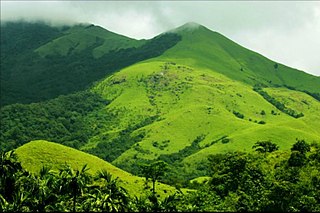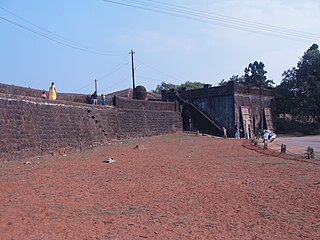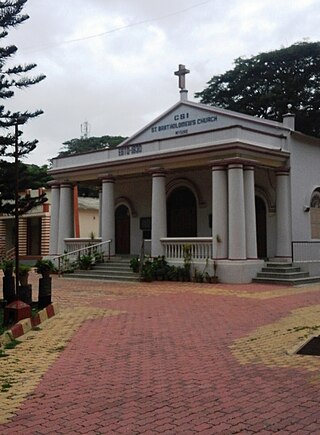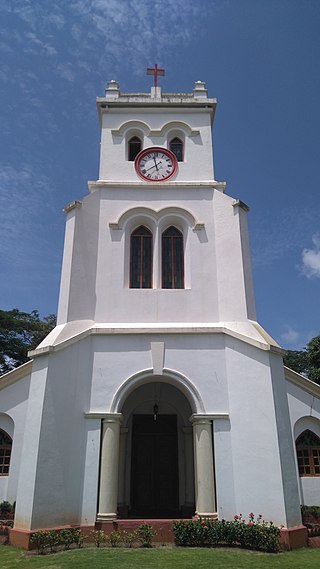
Kodagu district is an administrative district in the Karnataka state of India. Before 1956, it was an administratively separate Coorg State, at which point it was merged into an enlarged Mysore State.

Madikeri is a hill station town in Madikeri taluk and headquarters of Kodagu district in Karnataka, India.

The district of Kodagu in present-day Karnataka comprises the area of the former princely state of the same name.

Madikeri Fort, also called Mercara Fort, is a fort in Madikeri, in the Kodagu district of the Indian state of Karnataka, first built by Mudduraja in the second half of the 17th century. Mudduraja also built the palace within the fort. It was rebuilt and restructured in granite by Tipu Sultan, and the site was then renamed Jaffarabad. Madikeri Fort is one of the many forts built or rebuilt by Tipu Sultan during his reign in the second half of the 18th century. In 1790, Dodda Vira Rajendra took control of the fort. The palace underwent renovations by Linga Rajendra II from 1812 to 1814. The British made additions to the fort in 1834. Notable structures in the fort include two stone statues of elephants at the northeast entry and a church in the southeast corner.
The captivity of Kodavas (Coorgis) at Seringapatam was the period of capture, deportation, and imprisonment of Kodava Takk speaking Coorgis who rebelled against Tippu Sultan, the de facto ruler of the Kingdom of Mysore, they were caught during a number of attempts to suppress their rebellion in the 1780s.

The siege of Bangalore was a siege of the town and fortifications of Bangalore during the Third Anglo-Mysore War by forces of the British East India Company, led by Charles, Earl Cornwallis against a Mysorean garrison, while Tipu Sultan, Mysore's ruler, harried the camps and positions of the besiegers. Arriving before the town on 5 February 1791, Cornwallis captured the town by assault on 7 February, and after six weeks of siege, stormed the fortress on 21 March.
Nadikerianda Chinnappa (1875–1931) was an Indian compiler, poet, translator, army man, police officer, cricket player, singer and philanthropist from Kodagu.

The Coorg War was fought between the British East India Company and the State of Coorg in 1834. Defiance of the Raja of Coorg, a small state in South India, led to a short but bloody campaign in 1834. In February 1834, a force of 7,000 was assembled under the command of Brigadier General Lindsay to commence operations against the Raja, who had begun hostilities against the British. Due to the poor state of roads, the force was divided into four columns, which were to enter Coorg from different directions and converge on the capital of Mercara. On 11 March, the Northern Division under the command of Colonel Gilbert Waugh entered the territory of Coorg and on 3 April, the leading troops made contact with the enemy. At noon, the advanced guard arrived in front of the fortified position of Soamwar Pettah. The force launched an attack on the position but was forced to retreat after a severe mauling. The leader of the Coorg resistance at was 'Madanta' (Mathanda) Appachu. Similar fate was suffered by another column.

Coorg Province was a province of British India from 1834 to 1947 and the Dominion of India from 1947 to 1950. Mercara was the capital of the province. It was administered by a Commissioner and later, Chief Commissioner appointed by the Government of India. The Chief Commissioner, was usually based in Bangalore. From 1834 to 1881, the Chief Commissioner, was also the Commissioner of Mysore. From 1881 to 1940, the Chief Commissioner was usually the British Resident to the princely state of Mysore.
The Karnataka Central Diocese is one of the twenty-two dioceses of the Church of South India covering the central part of Karnataka.

The Kingdom of Coorg was an independent kingdom that existed in India from the 16th century until 1834. It was ruled by a branch of the Ikkeri Nayaka. From 1780 to 1788, the kingdom was occupied by neighbouring Mysore but the Rajah of Coorg was restored by the British and became a protectorate of the British East India Company on 26 October 1790. In 1834, the then Raja of Coorg rebelled against British authority, sparking the Coorg War. The brief conflict led to the British to annex the kingdom in the same year, who transformed the region into a province of British India.

St. Bartholomew's Church is an Anglican church, built by the Madras Government for the East India Company troops stationed in Kingdom of Mysore and is located in Lashkar Mohalla, on the Nilgiri Road, near the noisy Mysore sub-urban bus stand in Mysore City. The church grounds was consecrated on 29 November 1830 by Bishop Turner of Calcutta, (p. 327) and the building was completed in 1832. The church is named after Saint Bartholomew, one of the 12 apostles of Jesus Christ, and is said to have visited India in the first century AD, and preached the Christian gospel in the Kalyan, Thane and Raigad regions of present-day Maharashtra.

Garrison Cemetery is located in Seringapatam, on the banks of the river Cauvery, about 300m from the Bangalore Mysore Highway. It has about 307 graves of the European officers killed in the final assault on Tippu Sultan in 1799, and their family members. Among the graves, there are 80 graves of the officers of the Swiss ‘de Meuron Regiment’, and the rest of the graves are their family members.
St. Paul's Church is located in the corner of Old Poor House Road, and Bowring Hospital Road, next to the Bowring and Lady Curzon Hospital, Bangalore Cantonment, India. St. Paul's has the distinction of being the very first Tamil Anglican Church in the erstwhile Mysore State. St. Paul's celebrated its 175th anniversary in May 2014. Like most old churches of Bangalore, the congregation of St. Paul's is spread all across Bangalore.
St. John's Church is located in St. John's Hill, Cleveland Town, Bangalore Cantonment, India, in between Promenade Road and St. John's Church Road. The church is the fourth oldest Protestant church in the city, with a distinct red edifice and towering steeple, rising out of the leafy surroundings. The church is dedicated to St. John the Evangelist.

St. Paul's Church is an Anglican church in Mangalore, India.
Christ Church is located on Fort Road, near the District Collectorate, in the heart of Salem City, Tamil Nadu, India. The church has been serving the community for the last 140 years, since its consecration in 1875. The church services at Christ Church are conducted both in English and Tamil. The church was designed by architect Robert Fellowes Chisholm, who was a pioneer of the Indo-Saracenic architecture, and also designed the Senate House buildings of the University of Madras and the Madras Presidency College
St. John’s Church is located inside the Vellore Fort, Tamil Nadu State, India. The Church was raised in 1846 by the Government of Madras for the officers and men of the East India Company military station. The church is called after St. John the Evangelist. However, the church was never officially consecrated and hence not officially named as St. John’s Church. St. John's Church is the oldest standing church in the Vellore Diocese. The church stands inside the Vellore Fort, which is under the control of the Archaeological Survey of India, along with the Vijaynagar period Jalakanteswarar Temple, Tippu Mahal, Hyder Mahal, Candy Mahal, Badhusha Mahal and the Begum Mahal.
The East Parade Church, consecrated in 1865, is located on Mahatma Gandhi Road, in the Bangalore Cantonment. The church comes under the Karnataka Central Diocese of the Church of South India. Started in the early 19th century as the Wesleyan Mission Chapel by Wesleyan believers of the Madras Army with Tamil and English services, the Church now has services in Tamil and Malayalam. The name East Parade comes from its location on the East of the Parade Grounds of the Madras Engineer Group (MEG) regiment. The present church building was raised in 1865, on the site of the old Wesleyan Mission Chapel, with an inscription dated 6 October 1863 marking the laying of the foundation stone.

Dodda Vira Rajendra was the ruler of the Kingdom of Coorg from 1780 to 1809. He is considered a hero of Coorg history for having freed the kingdom from the occupation of Tipu Sultan, the king of Mysore. He later aided the British in their fight against Tipu Sultan.














